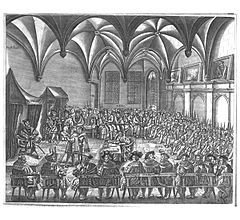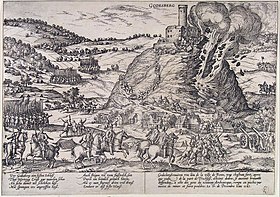Cologne War

Negotiating the Peace of Augsburg
|
|
| Date | 1555 |
|---|---|
| Location | Augsburg |
| Participants | Ferdinand, King of the Romans acting for Charles V. Delegates from the Imperial Estates |
| Outcome | (1) The principle of cuius regio, eius religio established religious conformity within a single state. Two confessions of faith were acceptable: Catholicism or the Augsburg Confession (Lutheranism). Any other expression of faith was heretical. (2) The principle of reservatum ecclesiasticum protected religious conformity within the ecclesiastical estates, but it did not clearly state how this was to be protected. (3) The Declaratio Ferdinandei granted certain exemptions to the principle of cuius regio, eius religio to some knights, sovereign families, and imperial cities. |
![]() Gebhard, Truchsess von Waldburg, Prince-Elector, Cologne 1578–1588
Gebhard, Truchsess von Waldburg, Prince-Elector, Cologne 1578–1588![]() House of Neuenahr-Alpen
House of Neuenahr-Alpen![]() House of Waldburg
House of Waldburg![]() House of Palatinate-Zweibrücken
House of Palatinate-Zweibrücken
The Cologne War (1583–88) devastated the Electorate of Cologne, a historical ecclesiastical principality of the Holy Roman Empire, within present-day North-Rhine-Westphalia, in Germany. The war occurred within the context of the Protestant Reformation in Germany and the subsequent Counter-Reformation, and concurrently with the Dutch Revolt and the French Wars of Religion.
...
Wikipedia

